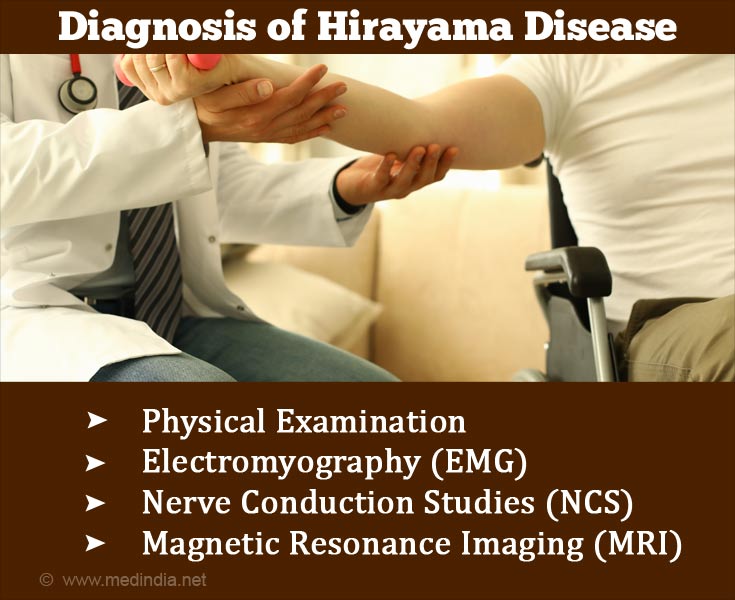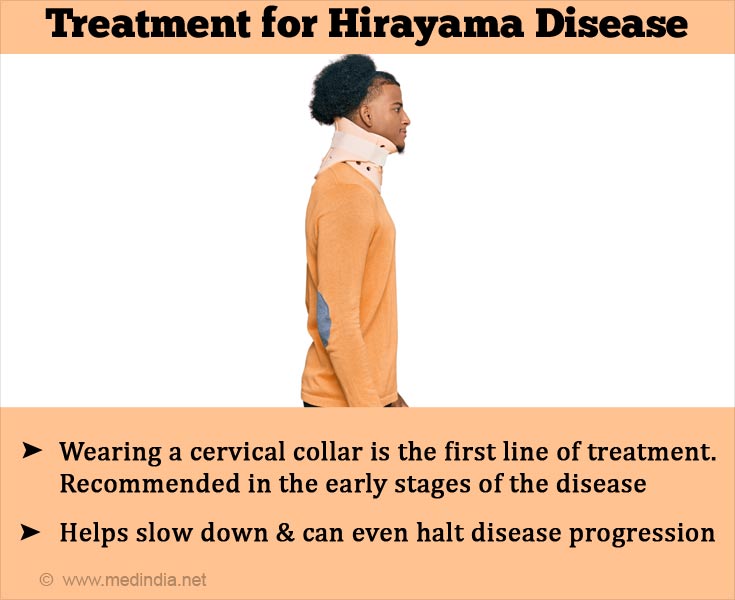How is Hirayama Disease Diagnosed?
There are several diagnostic approaches, which are highlighted below:
Physical Examination:
Physical examination will look for the following:
- Appearance: The right hand is deformed and wasted. The ability to grasp objects is lost. This is evident from the difficulty experienced by students to hold a pen for writing, which immensely hampers their studies
- Muscle Strength: The muscles (flexors and extensors) of the wrist and fingers in the affected hand, responsible for gripping become very weak. As a result, the patients are unable to use a key or pen or grasp objects
- Neurological Exam: The patient’s sensation remains intact. The patient is able to sense vibrations, temperature, touch (sharp, dull, light) on all extremities, and pain is absent. Muscle stretch reflexes also remain unaffected
Laboratory Tests:
Laboratory tests help to distinguish Hirayama disease from other similar clinical presentations.
Routine blood tests contribute to this differential diagnosis.
Other blood tests have shown that IgE levels are elevated. But the clinical significance of this finding in the context of Hirayama disease is unknown.
Standard X-rays do not yield any specific findings.
Magnetic Resonance Imaging (MRI):
MRI has the capability of detecting minute changes in the shape and structure of the spinal cord in the neck region of affected individuals.
In particular, a special type of MRI, known as “Flexion MRI” is able to show distinct changes in the alignment of the soft tissue structures, specifically the anterior movement of the dural sac, surrounding the spinal cord in the neck region.

Nerve Conduction Studies (NCS):
NCS helps to determine the speed of nerve impulse conduction through the nerves. Any changes in the nerve conduction velocity is indicative of an underlying pathological condition in the muscles innervated by these nerves. Importantly, significant changes are noted in the nerve conduction velocity of Hirayama disease patients, which help in diagnosing the condition.
Electromyography (EMG):
EMG measures the electrical activity of the muscles. Here also, just as in the case of NCS, significant changes are noted in the EMG patterns in the neck muscles of patients with Hirayama disease.
What is the Treatment for Hirayama Disease?
Although Hirayama disease is considered to be self-limiting, long-term consequences require treatment. There are essentially two treatment modalities – conservative and surgical. These are briefly discussed below:
Conservative Treatment:
The primary objective of conservative treatment is to reduce the number and frequency of injuries. This type of treatment modality involves mild and non-invasive therapeutic approaches, which are briefly highlighted below:
- Cervical Collar: Wearing a cervical collar is the first line of treatment. It is recommended in the early stages of the disease, as it reduces neck flexion. Reduced neck flexion arrests further compression of the spinal cord at the neck region. This helps to slow down and sometimes even halt disease progression. It is recommended to wear the cervical collar for 3-4 years, until the growth spurts are completed or plateauing of the condition occurs
- Physiotherapy: In this treatment modality, muscle-strengthening exercises of the affected hand, as well as hand-coordination training is imparted

Surgical Treatment:
Surgery is emerging as a good option for treating Hirayama disease. Surgical intervention is reserved for severe cases. The severity is confirmed by MRI, which shows atypical muscular involvement and severe spinal cord damage.
A common surgical intervention is duraplasty with tenting, which is associated with improved success rate and a better outcome.
A relatively new and specialized type of surgery is described below:
- Anterior Cervical Discectomy and Fusion (ACDF): This is a special type of surgery, where the cervical spine is opened-up and a small disc is removed from the neck area of the vertebral column and then fixed with a plate and screw. This brings about a slight reduction in the ability to bend the neck, which protects the spinal cord from overstretching. As a result, the muscle weakness in the hands stops progressing
Following surgery, the condition of the patient significantly improve, and the disease stops progressing. The power of the hand improves, and the bulk of the hand muscles also increase.
What is the Prognosis of Hirayama Disease?
Hirayama disease has a good prognosis, as the disease progresses slowly, so that there is ample opportunity for therapeutic intervention. Of all the treatment modalities, the prognosis following surgery is especially good, as it has a high success rate.







